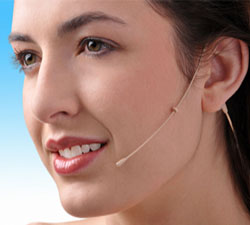Earset, headworn, and over-the-ear microphones are quickly taking the place of lavalier and handheld microphones in many houses of worship.
As with all microphones, choosing the right one for your application is important, so here I will discuss a few of the deciding factors all churches should consider, and I’ll make some recommendations on specific models.
Why choose an over-the-ear microphone in the first place? Since the diaphragms of most earset mics are mini-me sized, they won’t have the strong robust sound that a handheld or larger lavalier microphone has.
But don’t let their small size fool you – they can still provide very rich and professional performance. One of the most appealing benefits of an earset mic is that it stays in one place when worn properly, so regardless of whether the user moves his or her head, the mic stays at the same location.
This can be a sound tech’s favorite feature because he/she doesn’t have to constantly ride the fader or use a less-than-desirable compressor/expander setting on a dynamics processor to overcome the physical and mechanical moves that can occur, particularly with a more animated speaker or singer.
Here are a few points to consider when choosing an earset microphone:
1) What will the mic be used for? If it is for speech only, then its frequency response isn’t as much of a concern, so you have many options.
Offering defined clarity at a very affordable price, the OSP Audio HS-09 is one of my favorites for liturgy. If the mic needs to also handle the task of singing vocals, then that narrows the field a bit. You will need a mic with a high-quality capsule that can handle the added SPL, like the Sennheiser HSP4 or the DPA 4066, both of which are available in reduced-sensitivity versions for very loud vocals (be sure to specify your preference when ordering the mic).
2) Wired or Wireless? This might seem odd at first, but not all headworn mics require a wireless setup. For example, you might have a singing drummer, or the drummer might be the band leader and will need to communicate over a monitor system to the rest of the worship team.
Since his/her hands are occupied, a headworn mic is a good choice, but he/she won’t benefit from the freedom of movement that a wireless system would provide. So why not save some $ and go wired?
The same would apply for any team member who doesn’t necessarily need to move around. Almost any headworn or over-the-ear mic can be terminated for wired or wireless use – you just need to specify “XLR termination” when you order.




















